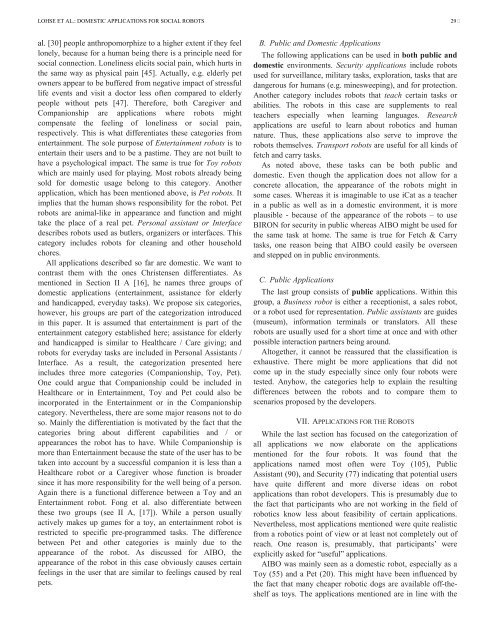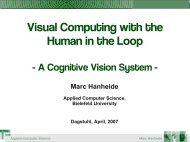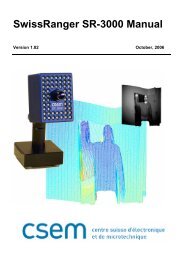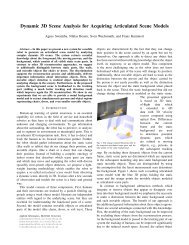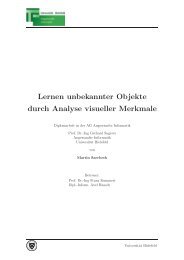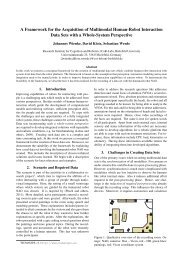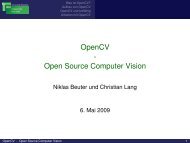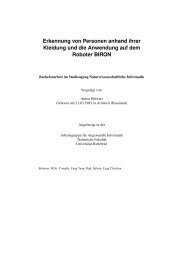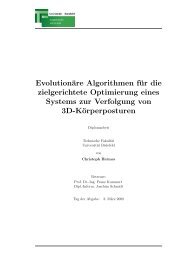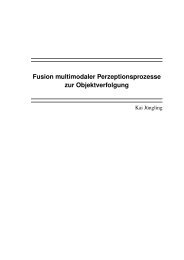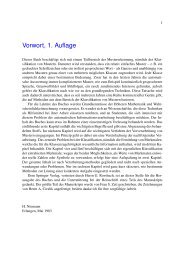Domestic Applications for Social Robots - Journal of Physical Agents
Domestic Applications for Social Robots - Journal of Physical Agents
Domestic Applications for Social Robots - Journal of Physical Agents
Create successful ePaper yourself
Turn your PDF publications into a flip-book with our unique Google optimized e-Paper software.
LOHSE ET AL.: DOMESTIC APPLICATIONS FOR SOCIAL ROBOTS 29<br />
al. [30] people anthropomorphize to a higher extent if they feel<br />
lonely, because <strong>for</strong> a human being there is a principle need <strong>for</strong><br />
social connection. Loneliness elicits social pain, which hurts in<br />
the same way as physical pain [45]. Actually, e.g. elderly pet<br />
owners appear to be buffered from negative impact <strong>of</strong> stressful<br />
life events and visit a doctor less <strong>of</strong>ten compared to elderly<br />
people without pets [47]. There<strong>for</strong>e, both Caregiver and<br />
Companionship are applications where robots might<br />
compensate the feeling <strong>of</strong> loneliness or social pain,<br />
respectively. This is what differentiates these categories from<br />
entertainment. The sole purpose <strong>of</strong> Entertainment robots is to<br />
entertain their users and to be a pastime. They are not built to<br />
have a psychological impact. The same is true <strong>for</strong> Toy robots<br />
which are mainly used <strong>for</strong> playing. Most robots already being<br />
sold <strong>for</strong> domestic usage belong to this category. Another<br />
application, which has been mentioned above, is Pet robots. It<br />
implies that the human shows responsibility <strong>for</strong> the robot. Pet<br />
robots are animal-like in appearance and function and might<br />
take the place <strong>of</strong> a real pet. Personal assistant or Interface<br />
describes robots used as butlers, organizers or interfaces. This<br />
category includes robots <strong>for</strong> cleaning and other household<br />
chores.<br />
All applications described so far are domestic. We want to<br />
contrast them with the ones Christensen differentiates. As<br />
mentioned in Section II A [16], he names three groups <strong>of</strong><br />
domestic applications (entertainment, assistance <strong>for</strong> elderly<br />
and handicapped, everyday tasks). We propose six categories,<br />
however, his groups are part <strong>of</strong> the categorization introduced<br />
in this paper. It is assumed that entertainment is part <strong>of</strong> the<br />
entertainment category established here; assistance <strong>for</strong> elderly<br />
and handicapped is similar to Healthcare / Care giving; and<br />
robots <strong>for</strong> everyday tasks are included in Personal Assistants /<br />
Interface. As a result, the categorization presented here<br />
includes three more categories (Companionship, Toy, Pet).<br />
One could argue that Companionship could be included in<br />
Healthcare or in Entertainment, Toy and Pet could also be<br />
incorporated in the Entertainment or in the Companionship<br />
category. Nevertheless, there are some major reasons not to do<br />
so. Mainly the differentiation is motivated by the fact that the<br />
categories bring about different capabilities and / or<br />
appearances the robot has to have. While Companionship is<br />
more than Entertainment because the state <strong>of</strong> the user has to be<br />
taken into account by a successful companion it is less than a<br />
Healthcare robot or a Caregiver whose function is broader<br />
since it has more responsibility <strong>for</strong> the well being <strong>of</strong> a person.<br />
Again there is a functional difference between a Toy and an<br />
Entertainment robot. Fong et al. also differentiate between<br />
these two groups (see II A, [17]). While a person usually<br />
actively makes up games <strong>for</strong> a toy, an entertainment robot is<br />
restricted to specific pre-programmed tasks. The difference<br />
between Pet and other categories is mainly due to the<br />
appearance <strong>of</strong> the robot. As discussed <strong>for</strong> AIBO, the<br />
appearance <strong>of</strong> the robot in this case obviously causes certain<br />
feelings in the user that are similar to feelings caused by real<br />
pets.<br />
B. Public and <strong>Domestic</strong> <strong>Applications</strong><br />
The following applications can be used in both public and<br />
domestic environments. Security applications include robots<br />
used <strong>for</strong> surveillance, military tasks, exploration, tasks that are<br />
dangerous <strong>for</strong> humans (e.g. minesweeping), and <strong>for</strong> protection.<br />
Another category includes robots that teach certain tasks or<br />
abilities. The robots in this case are supplements to real<br />
teachers especially when learning languages. Research<br />
applications are useful to learn about robotics and human<br />
nature. Thus, these applications also serve to improve the<br />
robots themselves. Transport robots are useful <strong>for</strong> all kinds <strong>of</strong><br />
fetch and carry tasks.<br />
As noted above, these tasks can be both public and<br />
domestic. Even though the application does not allow <strong>for</strong> a<br />
concrete allocation, the appearance <strong>of</strong> the robots might in<br />
some cases. Whereas it is imaginable to use iCat as a teacher<br />
in a public as well as in a domestic environment, it is more<br />
plausible - because <strong>of</strong> the appearance <strong>of</strong> the robots – to use<br />
BIRON <strong>for</strong> security in public whereas AIBO might be used <strong>for</strong><br />
the same task at home. The same is true <strong>for</strong> Fetch & Carry<br />
tasks, one reason being that AIBO could easily be overseen<br />
and stepped on in public environments.<br />
C. Public <strong>Applications</strong><br />
The last group consists <strong>of</strong> public applications. Within this<br />
group, a Business robot is either a receptionist, a sales robot,<br />
or a robot used <strong>for</strong> representation. Public assistants are guides<br />
(museum), in<strong>for</strong>mation terminals or translators. All these<br />
robots are usually used <strong>for</strong> a short time at once and with other<br />
possible interaction partners being around.<br />
Altogether, it cannot be reassured that the classification is<br />
exhaustive. There might be more applications that did not<br />
come up in the study especially since only four robots were<br />
tested. Anyhow, the categories help to explain the resulting<br />
differences between the robots and to compare them to<br />
scenarios proposed by the developers.<br />
VII. APPLICATIONS FOR THE ROBOTS<br />
While the last section has focused on the categorization <strong>of</strong><br />
all applications we now elaborate on the applications<br />
mentioned <strong>for</strong> the four robots. It was found that the<br />
applications named most <strong>of</strong>ten were Toy (105), Public<br />
Assistant (90), and Security (77) indicating that potential users<br />
have quite different and more diverse ideas on robot<br />
applications than robot developers. This is presumably due to<br />
the fact that participants who are not working in the field <strong>of</strong><br />
robotics know less about feasibility <strong>of</strong> certain applications.<br />
Nevertheless, most applications mentioned were quite realistic<br />
from a robotics point <strong>of</strong> view or at least not completely out <strong>of</strong><br />
reach. One reason is, presumably, that participants’ were<br />
explicitly asked <strong>for</strong> “useful” applications.<br />
AIBO was mainly seen as a domestic robot, especially as a<br />
Toy (55) and a Pet (20). This might have been influenced by<br />
the fact that many cheaper robotic dogs are available <strong>of</strong>f-theshelf<br />
as toys. The applications mentioned are in line with the


